
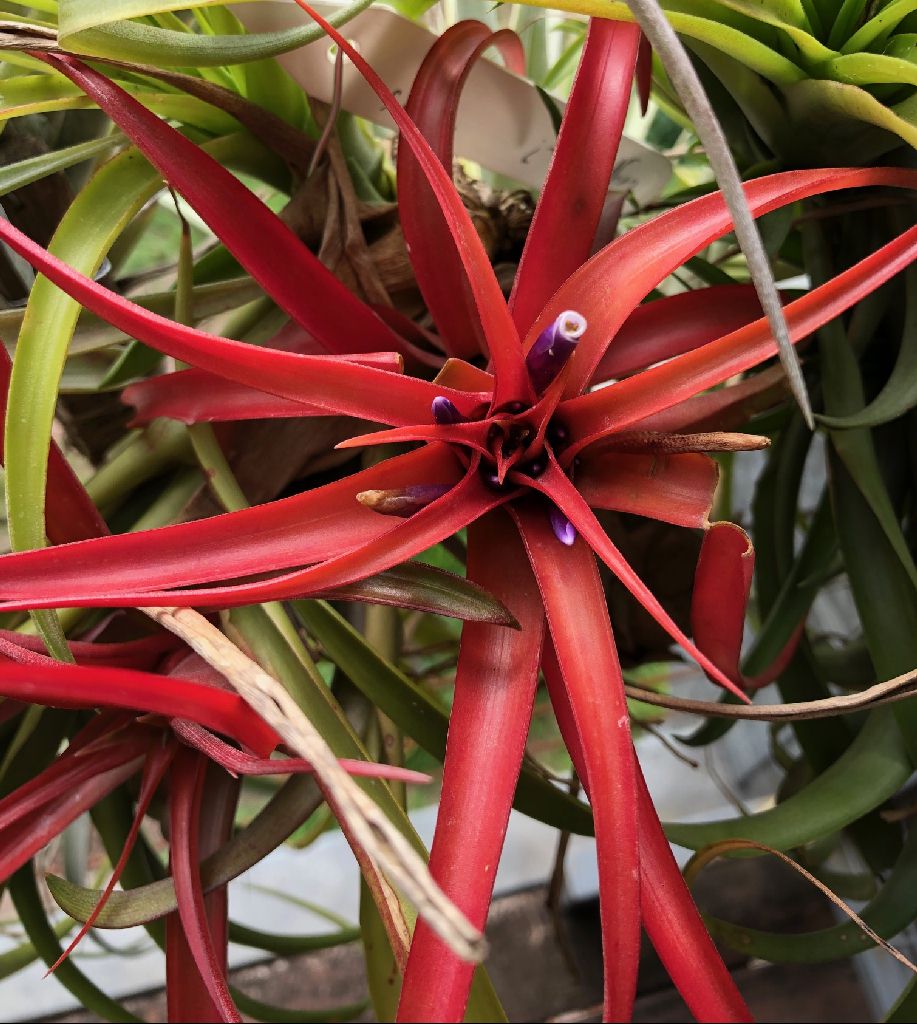


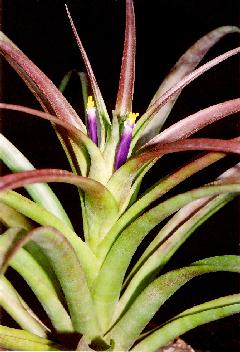
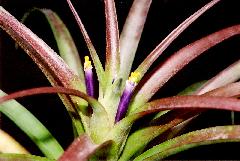
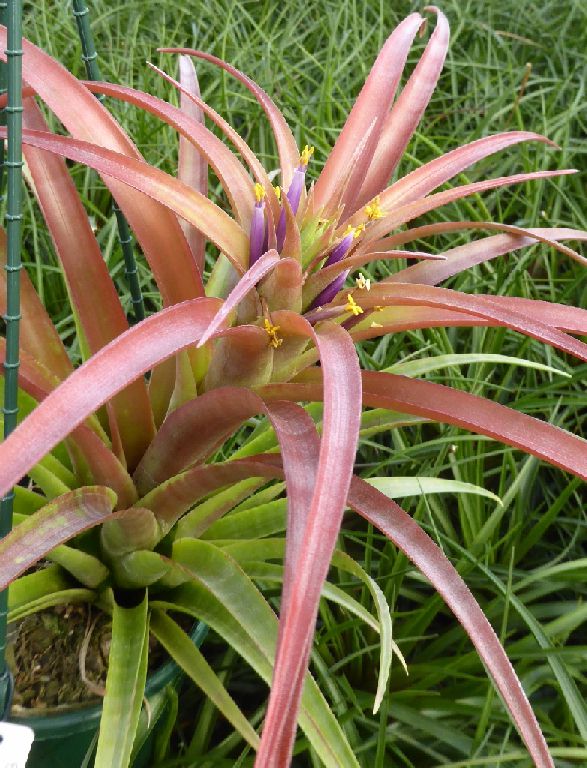
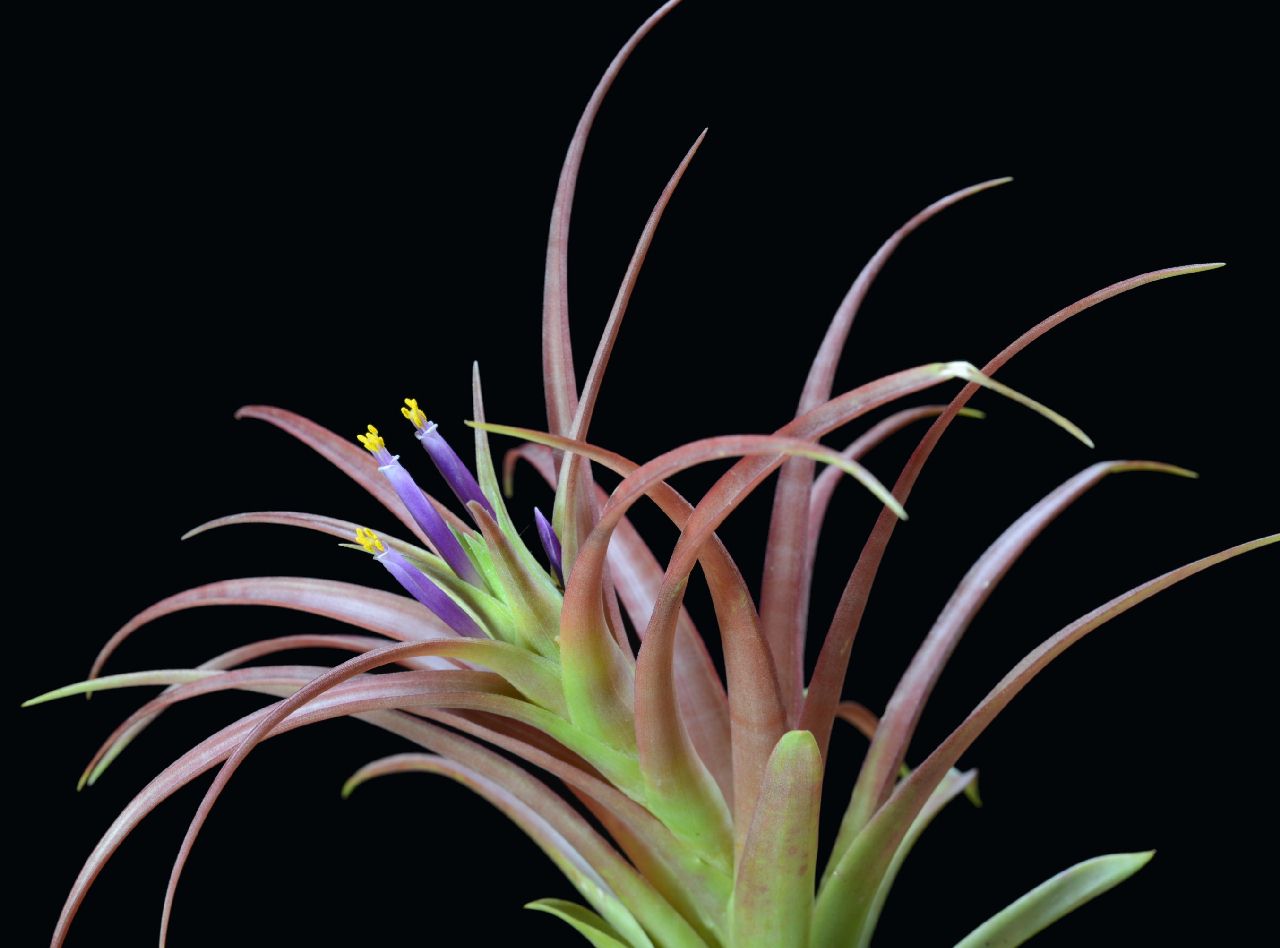

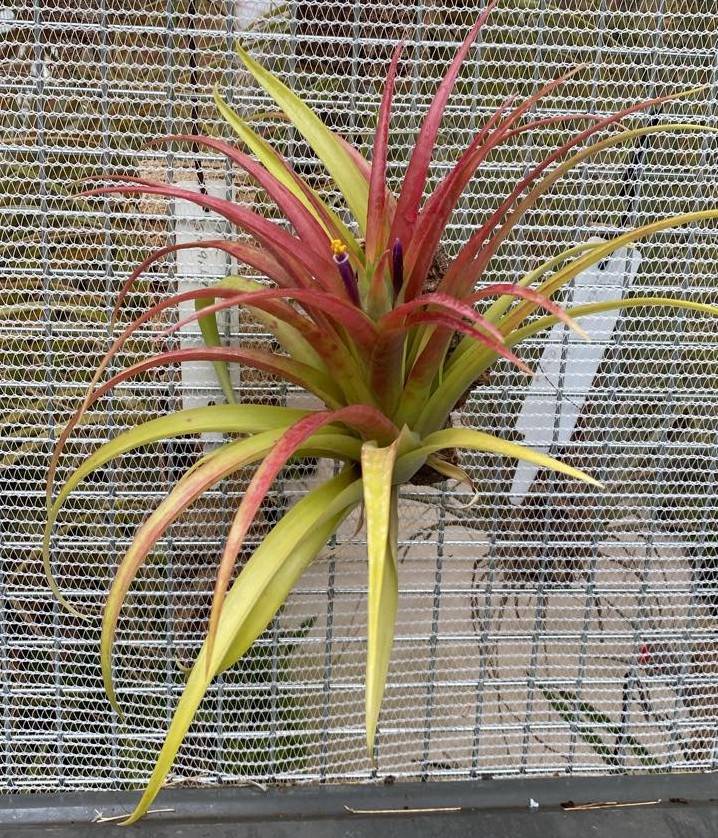
Plant flowering to 20 cm. high, strong growing.
Leaves forming an inflated rosette, a few outside leaves turn a shiny red at anthesis, decurved, to 20 cm. long, 20 mm. wide above the sheath, then narrowing to a tip, glabrous to the very small lepidote.
Scape very short, however producing flowers above the leaf rosette, hidden by the very dense leaf rosette.
Inflorescence almost many flowered, cup shaped like a corymb. very dense.
Primary bracts all leaf like, flaming red, concealing all the spikes.
Spikes to 25mm. long, 1 – 3 flowered, clearly distichous, fan shaped, sessile.
Flower bracts smooth, glabrous, almost membraneous or almost leathery, ovate elliptic, barely keeled, broad acute, shorter than the sepals.
Flower strictly erect, emerging from the primary bracts, to 70mm. long.
Sepals posterior pair joined higher than the front one, elliptic, acute, sub- membraneous, glabrous, minutely veined, to 17mm. long.
Petals strict, erect tube, deep violet, much longer than the stamens.
Habitat Costa Rica near San Jose
Tillandsia abdita L. B. Smith, Phytologia 8: 10 ,Pl. l , fig. 15-17. 1961.
Desc from S&D p1001 for protologue see jpg
Plant stemless.
Leaves numerous, suberect, 16 cm long, covered with appressed cinereous scales, reddish;
Sheaths merging with the blades;
Blades narrowly triangular , attenuate, ca 2 cm wide, slightly recurving.
Scape very short, wholly concealed by the leaves.
Inflorescence depauperate-compound, few-flowered, capitate, much exceeded by the leaves;
Primary bracts foliaceous but reduced, much exceeding the spikes;
Spikes densely 2-flowered, complanate.
Floral bracts oblong, acute, 17 mm long, exceeding the sepals, carinate, membranaceous, subdensely lepidote with pale brown appressed scales;
Flowers subsessile.
Sepals free, exactly like the floral bracts;
Petals and stamens unknown.
Type. Solis 314 (holotype F), Cerro de Escasu, San Jose, Costa Rica, Aug 1935.
DISTRIBUTION. Known from the type collection only.
Description by J Francisco Morales in INBio Instituto Nacional de Biodiversidad 24 Sept 1999
Plant epiphytic
Leaves 9.5 – 19.5 (27.5) cm long, chartaceous to sub-coriaceous.
Sheath 2.3 – 3.3cm wide, cinnamon, adpressed lepidote, passing gradually to the blade.
Blade 1.4 – 2.2cm wide, triangular, densely lepidote, usually mulberry to reddish-mulberry.
Scape 5.5 – 10cm long, erect, hidden by the leaves.
Scape bracts leaflike, much longer than the inflorescence.
Inflorescence erect, 4 – 5cm long, capitate to sub-capitate, terminal, bracts much larger than the side branches which are less than 2cm, with 1 – 2 flowers.
Floral bracts 1.7 – 2.2cm, much longer than or equal to the sepals, ecarinate, nerved, glabrous, membranaceous to sub-chartaceous.
Sepals 1.7 – 2cm long, lepidote, membranaceous.
Petals lilac.
Capsules 2.9 – 3.6cm
Distribution Endemic. Cerros de Escazu, Cordillera de Talamanca (El Rosario, Llano Los Angeles), Cerros de Caraigres, Elevation between 1600 – 2000m
NOTES: From Derek Butcher.
Francisco Morales of Costa Rica has been doing some research (Sept 1999) into this species - Refer INBio Web site. He refers to Smith’s original description but does not point out the differences that he must have found and should have commented on. He has not responded to my queries! These are:-
carinate lepidote | not carinate glabrous | |
Tillandsia brachycaulos Schlechtendal, Linnaea 18: 422. 1844.
Tillandsia cryptantha Baker, Jour. Bot. London 26: 142. 1888. Type. Cuernavaca, Morelos, Mexico, Bourgeau 1423 (K, GH photo), 15 Nov 1865.TREATED BY GARDNER AS A SEPARATE SPECIES
Tillandsia bradeana Mez & Tonduz ex Mez, Repert. Sp. Nov. 14: 252. 1916. Type. San Jose, Costa Rica, Werckle 37 (costar 16412) (B, B photo 1191/23).TREATED IN BINOMIALS 8, 2002 AS THE CORRECT NAME FOR T. ABDITA
?Tillandsia flammea Mez in Pflanzenreich IV. Fam. 32: 478. 1935. Type. Costa Rica, Tonduz s n (B?, n v). Described from living material.
Desc from S&D p1000-1 INCLUDES THE TWO SYNONYMS SO IT IS BETTER TO USE THE DESCRIPTION IN MEZ 1935 – See below- Note differences in floral bracts and sepals
Plant stemless;
Leaves subrosulate, numerous, spreading to arching-decurved, often secund, 12-26 cm long, much exceeding the inflorescence, densely and finely appressed-lepidote;
Sheaths distinct, ovate, 3-5 cm long, brown-lepidote;
Blades linear, filiform attenuate, 8-20 mm wide, flat or involute.
Scape short to none, erect, slender, glabrous;
Scape-bracts foliaceous, very densely imbricate, equaling or exceeding the inflorescence.
Inflorescence compound at base or appearing simple and polystichous-flowered by the reduction of the spikes to a single flower each, densely capitate or subcorymbose, few-flowered;
Primary bracts like the scape-bracts with long foliaceous blades many times exceeding the axillary spikes;
Spikes with a few sterile bracts at base.
Floral bracts lanceolate or oblong, obtuse, about equaling the sepals, membranaceous, prominently nerved, glabrous;
Flowers erect, sessile.
Sepals narrowly elliptic, obtuse, 12-17 mm long, membranaceous, free or the posterior ones much connate even in the same spike;
Petals linear, 5-7 cm long, tubular-erect, violet;
Stamens and pistil exserted.
Capsule cylindric, acute, 4 cm long.
Type. Schiede s n (holotype B?, n v), Hacienda de La Laguna, Vera Cruz, Mexico.
DISTRIBUTION. Epiphytic in dry woods, 600-1200 m alt, Mexico, Central Ameri¬ca. MEXICO. SAN LUIS POTOSI: Tamazunchale, Ju11938, Foster 1172 (GH); 24 Jul 1940, Hitchcock & Stanford 7323 (US). VERA CRUZ: Tantoyuca, 1858, Ervendberg 276 (GH); Zacuapan, Aug 1906, Purpus 2105 (GH, NY, UC, US); Apr 1919, 8217 (MO, NY, UC, US); Xalapa, 3 Aug 1947, Barkley, Howell & Webster 2622 (TEX); Barkley, Paxson & Webster 2629 (F, TEX). MORELOS: San Antonio, Cuernavaca, 1 Dec 1932, Froderstrom & Hulten 1332 (S). OAXACA: Ixtlan de Juarez, 21 Jun 1939, Schultes 662-A (GH). TABASCO: Tierra Colorada, 17 jun 1888, Rovirosa 193 (US); Tenosique, Jun 1892, Beristain 7825 (F, GH). CHIAPAS: Rio Jatate, Ocosingo, 8 Apr 1967, Breedlove 15633 (DS). CAMPECHE: Vapor, Palizada, JuI 1939, Matuda 3882 (GH, MEXU). YUCATAN: Merida,Jul 1865, Schott 557 (F); lzamal, Gaumer 742 (F, US); 21 Feb 1906, Greenman 404 (CH); Chichen Itza, 29.Jun 1932, Steere 1622 (MICH); 1938, Lundell 7578 (GH, MICH, US); Muna, Jul 1932, Steere 2166 (MICH). GUATEMALA. PETEN: Uaxactun, 7 Apr 1931, BartIett 12514 (GH); La Libertad, 20 Apr 1933, Lundell 2908 (MICH); 12 Jun 1933, 3753 (MICH); Tikal, 1959, Lundell 15307 (LL, US); 15596 (LL); 16067 (LL, US); Feb 1960, Contreras 568 (LL); 570 (LL); 646 (LL, US); 648 (LL); May 1960, 987 (LL, US); Jun 1960, 1040 (LL); 1071 (LL); Ju11960, 1353 (LL). IZABAL: Izabal to Mariscos, 30 May 1966, Jones & Facey 3523 (NY, US). SAN MARCOS: Rio Cabus, Volcan Tajumulco, 12 Mar 1940, Steyermark 37638 (F). ZACAPA: Gualin, 15 Jun 1909, Deam 6298 (US). SANTA ROSA: Santa Rosa, Ju11892, Heyde & Lux 3539 (GH, US); Cuilapa, 24 Nov 1940, StandIey 78181 (F). HONDURAS. CORTES: San Pedro Sula, 15 Ju1 1887, Thieme 190 (US). COMAYAGUA: Siguatepeque, 22 Jul 1964, GiImartin 1007 (US). YORO: Coyoles, 1938, Yuncker, Koepper & Wagner 8190 (GH, US). PARAISO: Rio California, Sierra de la Villa Santa, 31 Dec 1950, Williams 17335 (EAP, US); Escuela, 8 Ju1 1964, GiImartin 942 (US). SALVADOR. SANTA ANA: Desagiie, 6 Feb 1951, Rohweder 103 (HBG); 105 (HBG); Agua Caliente, 12 Jul 1951,Rohweder 121 (HBG). SONSONATE: Los Cobanos, 10 May 1951, Rohweder 112 (HBG). LIBERTAD: Santa Tecla, 28 Mar 1951, Rohweder 106 (HBG); Laguna de Zapotitin, 9 Apr 1951, Rohweder 108 (HBG); 1 Jun 1951, 113-116 (HBG). CHALATENANGO: Rio Sumpul, 21 Nov 1950, Rohweder 122-123 (HBG). NICARAGUA. CHINANDEGA: Chinandega, 27 Jan 1903, Baker 2158 (POM). CARAZO: Santa Teresa, 27 Dec 1968, Atwood 1275 (US); 1276 (US). RIVAS: Belen 7 Jan 1969, Atwood 1923 (US). WITHOUT EXACT LOCALITY: Levy 91 (B); Wright s n (US). COSTA RICA. GUANACASTE: Tilaran, Jan 1926, StandIey & VaIerio 44170 (US); 45729 (US); 30 May 1932, Kupper s n (M). SAN JOSE: El Brazil, Santa Ana, 9 May 1930, Dodge 7891 (GH). PANAMA: CHIRIQUI: Remedios, 30 May 1946, Allen 3478 (MO, US). WITHOUT EXACT LOCALITY: Wagner s n (M).
LOCAL NAMES. Yucatan. Spanish: gallitos. Mayan: chu, mexnuxib, miz.
Tillandsia brachycaulos Schltdl., Linnaea 18: 422. 1844. in Selbyana 15(2). 1994
SPECIMENS EXAMINED. Aragua: Maracay, Jardines de la Facultad de Agronomia de la UCV, 450 m, 15 Agosto 1988, Carnevali & I. Ramirez 2739, (VEN); Ocumare de la Costa, bosque seco tropical atmosfericamente seco, 0-50 m, 26 Enero 1986, Carnevali. I. Ramirez & Fleming 1989 (VEN); 4-5 km NE de Tejerias. Autopista Caracas-Valencia, bosque seco premontano, 400-500 m, 7 Marzo 1986, Carnevali & I. Ramirez 2003 (VEN). Bolivar: Distrito Paez, La Grulla, 6 km al SE de Upata, bosque semideciduo, 340 m, Julio 1978, Delascio & Liesner 6830 (VEN).
This species was previously known only from Central America, from Mexico to Panama. It is to be expected in Colombia. Tillandsia brachycaulos is another instance of a basically Caribbean or Central American member of the genus that reaches its southernmost limit in Venezuela. Other examples are Tillandsia fasciculata Swartz. T. balbisiana Schultes f., T. flexuosa Swartz, and T. juncea (Ruiz & Pavon) Poiret.
Tillandsia brachycaulos is widespread and locally common in Venezuela, but has been overlooked by previous plant collectors since it looks like a sterile plant of something like T. variabilis Schltdl., especially since the bracts of the Venezuelan populations are not as brightly colored as the Central American populations.
Tillandsia brachycaulos var. multiflora L B Smith, Cont. Gray Herb. 154:35, Pl 4, fig.3. 1945
SAID BY UTLEY (DEREBUS I 1994)TO BE caput-medusae x brachycaulos a natural hybrid – as yet to be proven. No plants following this description have been found in the vicinity since the original collection.
Plant stout; spikes to 4-flowered
(Originally ‘robustior; spicis elongatis, sublaxis, ad 4-floris.’)
Type Steyermark 29465 (Holotype F), Rio Hondo, Zacapa, Guatemala, 10 Oct. 1939.
Distribution. Known from the type collection only.
From Mez 1935
59. T. brachycaulos Schlechtend.Linnaea XVIII. (1844) 422;
Morr. in Belg. Hortic. XXVIII. (l878) 185, t. 11. –Vix ultra 0,15 m alta. Folia utriculatim rosulata, omnia ut in specie praecedente et sequente arcuatim decurvata, usque ad 0,25 m longa, super vaginam ad 18 mm lata, inde in apicem sensim angustata, per anthesin omnia flammide rubentia, vel extrema tantum virentia, minutissime lepidota glabrorum speciem praebentia. Scapus quamvis brevis tamen manifestus, flores ultra rosulae centrum efferens, densissime foliis omnino iis rosulae aequalibus indutus et celatus. Inflorescentia subpauciflora, cyathidiiformis, valde abbreviata subcorymbosa; bracteis primariis quam vaginae scapales mediae interioresque saltem bene brevioribus cet. illis isomorphis, spicas omnino celantibus; spicis quam maxime reductis 1-floris, flore altero reducto nonnunquam accedente, brevissimis; bracteis florigeris membranaceis, ovato-ellipticis, haud carinatis, sepala superantibus. Flores stricte erecti, ad 50 mm longi; sepalis posticis inter sese altius quam cum antico connatis, ellipticis, rotundatis, glabris. Petala pallide vel saturate violacea, tubulose erecta, quam stamina breviora.
Mexico: Hacienda de la Laguna (Sc h i e d e), Tabasco (Rovirosa n. 193), bei Tihuatlan (Karwinsky). Yucatan (Gaumer n. 742. Schott). Guatemala: bei Sta. Rosa (Heyde und Lux, ed. Donnell-Smith n. 3539). Honduras (Thieme n. 190). Nicaragua (Levy n. 91). Costarica (Herb. inst. phys.-geogr. Costaric. n. 2927, leg. Pittier). Panama (Wagner). - Von Tondus lebend eingefuhrt.
Translated by Butcher:
Plant barely up to 15cm high
Leaves forming a rosulate utriculum, all as in the preceding and following species decurved, up to 25cm long, to 18mm wide above the sheath, then gradually narrowing to the tip, near anthesis all a flaming red or merely green at the ends, the minutest lepidote showing the species as glabrous.
Scape very short but visible, flowers being produced above the centre rosette, clothed very densely by all the leaves equalling the rosette and hidden.
Inflorescence few flowered, cyathiform, very short corymbose.
Primary bracts at least on the inside much shorter than the middle of the sheath of the scape bracts, otherwise the same shape, totally hiding the spikes, larger than the spikes that are reduced to 1 flower, sometimes other flowers are reduced to near this, very short.
Floral bracts membranaceous, ovate elliptic, not at all carinate, exceeding the sepals
Flowers strictly erect, to 50mm long.
Sepals posterior ones higher connate than with the anterior sepal, elliptic, rounded, glabrous.
Petals pale or deep violet, tubular erect, shorter than the stamens.
Detail from Mez 1935
58. T. flammea Mez nov. spec. –
Infra 0,1 m alta. Folia explanato-rosulata, ad 0,12 m longs, super vaginam ad 8 mm lata, inde in apicem acutissimum sensim angustata, per anthesin rosulae omnia fulgide flammea, quam maxime appresse lepidota glabrorum speciem praebentia. Scapus plane nullus, unde flores inter folia rosulae intima emergentes. Inflorescentia pauciflora, e bracteis primariis omnino foliis rosulae aequalibus nec multo diminutis, spicas quam maxime reductas, 1-floras in axillis gerentibus et omnino celantibus formata; bracteis florigeris membranaceis, subovatis, acutiusculis, glabris, haud carinatis, sepala paullo superantibus. Flores stricte erecti, genitalibus computatis ad 65 mm longi; sepalis posticis binis manifeste altius inter sese quam cum antico connatis, ellipticis, rotun-datis, membranaceis, glabris, ad 20 mm longis. Petala strictissime tubulose erecta, saturate violacea, quam stamina optime breviora.
Costarica: von Tonduz lebend ubersandt.
Translated by Butcher:
Under 10 cm high.
Leaves a flattened rosette, to 12 cm long, above the sheath to 8 mm wide, then gradually narrowing to a very acute tip, throughout anthesis the whole rosette a bright scarlet, making a much more strongly appressed lepidote than glabrous species.
Scape clearly absent, from whence the flowers emerge internally between the leaf rosette.
Inflorescence few flowered, primary bracts equaling the rosette leaves not much smaller, spikes greatly reduced, having 1 flower in the axil and all hidden;
floral bracts membranaceous, subovate, becoming acute, glabrous, not at all carinate, exceeding a little the sepals.
Flowers strictly erect, genitalia together to 65 mm long;
sepals posterior pair clearly higher connate than the anterior one, elliptic, rounded, membranaceous, glabrous, to 20 mm long.
Petals very strictly tubulose erect, deeply violet, much shorter than the stamens.
Costa Rica: living plant sent over by Tonduz.
Key in Mez shows T. flammea has no scape and T. brachycaulos has short scape.
Key from Mez 1935
:: Inflorescentia sessilis vel subsessilis.
- / Sepala libera ==> 57 . T. cryptantha.
- - // Sepala postica altiuscule connata.
- - - ' Plane acaulis, floribus in rosulae centro nidulantibus ==> 58. T. flammea.
- - - - " Inflorescentia scapo brevi, undique foliato super rosulam elata.
- - - - - ! Flores ad 50 mm longi ==> 59. T. brachycaulos.
- - - - - !! Flores ad 70 mm longi ==> 60. T. Bradeana.
Tillandsia cryptantha Baker in Journ. of Bot XXVI 142 (1888)
Treated by Gardner (1982) as a species in its own right with the comment, “It may be distinct from T. brachycaulos based on photo of the type”. This was accepted by Luther and is in the Binomials listing.
No further information is available but we do know that on 1/3/1983 Walter Till made a comment on the Holotype folio that in his opinion this was a synonym of T. brachycaulos. Therefore, from April 2015 Butcher will be following this judgement.
Tillandsia cryptantha Baker in Journ. of Bot XXVI 142 (1888)
Treated by Smith & Downs as a synonym of T. brachycaulos.
57. T. cryptantha Bak. in Journ. of Bot. XXVI. (1888) 142. – From Mez 1935
Parvula, vix ultra 0,2 m alta. Folia manifeste utriculatim rosulata, usque ad 0,25 m longa, super vaginam usque ad 20 mm lata, inde in apicem subfiliformem sensim angustata, utrinque lepidibus appressis in vivo quoque canescentia. Scapus brevissimus nunc brevis, densissime foliis iis rosulae aequalibus obtectus et celatus. Inflorescentia pauciflora, in scapi apice ultra rosulam paullo elata cyathidiiformis, flores inter bracteas primarias maximas emergentes ostendens; bracteis primariis omnino foliaceis, ex, ovato-elliptico perlonge laminigeris, sicut folia lepidotis, in axillis spicas quam maxime abbreviatas quasi rudimentarias 1- vel rarissime 2-floras gerentibus; bracteis florigeris submembranaceis, ex ovato acutis, apicem versus medio prominulo-lineatis nec revera carinatis, in parte superiore lepidotis, usque ad 20 mm longis, sepala superantibus. Flores stricte erecti, ad 45 mm longi; sepalis fere aequaliter liberis, submembranaceis, late ellipticis, rotundatis, haud carinatis, laevibus vel minute venoso-lineatis, ad 14 mm longis. Petala pallide violacea, sepalis 2,5-plo longiora, tubulose erecta, quam stamina optime breviora.
Mexico: bei Cuernavaca (Bourgeau n. 1423), bei Tehuacan (Purpus). Nicaragua : bei Chinandega (C. F. Baker n. 2158). – Von Purpus lebend eingefuhrt.
Translated by Butcher:
Plant small, barely more than 20cm high.
Leaves many forming an inflated rosette, up to 25cm long, 2cm wide above the sheath, then narrowing to an almost filiform tip, both sides with appressed scales, becoming grey.
Scape very short to short, hidden, covered by and equalling the very dense leaf rosette.
Inflorescence few flowered, in the top of the scape a little above the leaf cup, displaying its emerging flowers between the large primary bracts.
Primary bracts all leaf like, (10cm long- from Baker 1889), from ovate elliptic to long blades, as lepidote as the leaves,
Spikes in the axils, much abbreviated, almost rudimentary, producing 1 or rarely 2 flowers.
Floral bracts submembranaceous, from ovate to acute, top towards the middle with prominent lines, never actually keeled, the upper part lepidote, up to 20mm long. exceeding the sepals.
Flowers strictly erect, to 45mm long, (short stout pedicels- from Baker 1889)
Sepals equally free, sub membranous, broad elliptic, (oblong- from Baker 1889), rounded, not at all keeled, smooth or with small lined veins, to 14mm long.
Petal pale violet, 2.5 times as long as the sepals, (=35mm long) forming an erect tube, much shorter than the stamens.
Habitat Mexico, near Cuernavaca (Bourgeau n. 1423), near Tehuacan (Purpus), Nicaragua, near Chinandega (CF Baker n. 2158)
311. T. CRYPTANTHA Baker in Journ. Bot. 1898, 142.
Leaves few in a rosette, lanceolate-acuminate from an ovate base an inch broad, 8-9 in. long, 1/2 in. broad at the middle, coriaceous, finely lepidote. Peduncle much sliorter than the leaves; bract-leaves crowded, with long lanceolate free points. Inflorescence a dense globose multifarious capitulum; flower-bracts ovate -acuminate, 4 – 5 in. long, like the leaves in texture. Calyx above 1/2in. long; sepals oblong, acute. Petals not seen. Capsule twice as long as the calyx.
Habitat: Mexico; Cuernavaca, Bourgeau 1423!